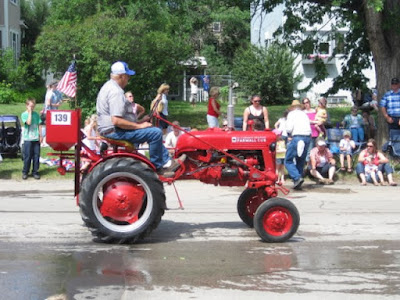Isn't this a pretty sight? We were bringing cow/calf pairs in early this morning just as the sun was coming up. There's a golden glow over us at this time of day and we were riding right in the middle of it. Sounds a little like a fairytale, doesn't it? But it's not, really. Just ask my sons if they enjoyed getting up at 4:30 a.m. Never mind the fact that while we were out there riding horseback we had deer flies biting us, mosquitoes and gnats flying in our ears, noses, and eyes, and then there are the bugs that you breath in through your mouth! (Do you remember the OFF mosquito repellant commercials where the guy puts his arm in a square box that's swarming with mosquitoes and not one bites him? That was what it was like in this particular pasture today -- swarming mosquitoes.) But never mind all that.
I sure have appreciated all your comments lately -- I enjoy each one -- but something I've been noticing is that many of you think that I live on a farm. Well, I do not. I live on a ranch. I'm sure some of you are thinking, "Farm, ranch. Ranch, farm. What's the diff?" Let me explain the differences.
A farm is a tract of land (including buildings) that is mainly used for raising crops like corn, wheat, rice, fruit, veggies and such. There are also farms that raise livestock, like dairy farms or pig farms or chicken farms, but farms usually produce the grains needed to feed their livestock. Ranches, on the other hand, are large tracts of land (including buildings), typically found in the Western US and Canada (I'm also thinking about large sheep and cattle ranches in Australia) that are used primarily for
grazing livestock. Some ranches raise crops like wheat or hay, but most often, typical ranches are arid to semi-arid with no irrigation and sparse rainfall for growing crops. Of course, there are always a few exceptions, but in short, ranches produce livestock, farms produce crops.
(a pic of the same pasture in 2007)
Out where we live, the average annual precipitation is 11-12 inches. That's not very much, is it? Our area is typically very arid, and cows and sheep graze native prairie grasses. It takes about 40 acres of land to graze just one animal unit per year in this ranch country. Some folks try to plant a little wheat here. Sometimes it works, but more often, it doesn't. We raise our own hay for our livestock for the cold months when the snow buries the grass and there is no grazing to be had. Most years we can put up enough hay for the winter, but sometimes we don't due to the weather conditions. A year like this one, however, we're getting triple what we normally put up in hay in an average year. We have been in a wet weather pattern the past three years and have had bumper hay crops, but before that, we were in a serious seven year drought and had to buy most of our winter feed.
The thing that farmers and ranchers have in common is that they live off the land. Both raise protein. The farmer raises protein in the form of grains, and the higher the protein levels in his grain, the better the prices. The rancher raises protein in the form of meat by grazing native grass. The more pounds of protein he can produce, the better his paycheck is.
I was thinking today of how a farmer and a rancher would use a horse. You recall that Old MacDonald had a horse. Well, John Wayne had a horse too, but he was a rancher in the old movie "The Cowboys." The farmer used the horse to plow the ground, to plant crops, and to harvest crops. The rancher, on the other hand, used his horse to move livestock from pasture to pasture for grazing, and then used the horse to move his livestock to the markets to sell them.
Some of you who are reading already know this stuff, but for those of you who aren't familiar with farming and ranching, I just thought I'd share a tidbit of agri-culture with you! Now don't you feel more cultured? For more ranch knowledge, check out the original movie trailer (below) for
The Cowboys, starring John Wayne. It is one of our family's favorite movies.
(note: There is a bit of rough, cowboy language in this movie.)











































